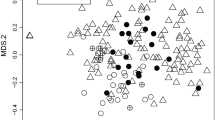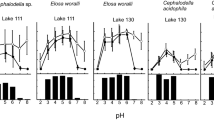Abstract
Canada’s oil sands hold the third largest petroleum reserves worldwide and have experienced rapid economic growth. The oil sands region provides an ideal location for studying local adaptations through reciprocal transplant (RT) because populations within the region have been historically exposed to naturally occurring bitumen. Our objectives were to (1) determine if Hyalella azteca from habitats within the oil sands region exhibited increased tolerance to constituents associated with industrial bitumen extraction compared with H. azteca from habitats outside the region; and (2) determine if any observed tolerance was attributable to local adaptation. Five populations of H. azteca were reciprocally transplanted from reclaimed and reference wetlands: four from local wetlands plus one naïve laboratory population. Survival, toxicity, and behaviour were measured before and after the RT period. Survival varied by population and site. These results show that the differences in responses among populations are likely not attributable to local adaptation and that laboratory populations of H. azteca provide ecologically relevant results when tested in the field.
Graphical Abstract







Similar content being viewed by others
References
Allen EW (2008) Process water treatment in Canada’s oil sands industry: I. Target pollutants and treatment objectives. J Environ Eng Sci 7(2):123–138
Antonovics J, Primack RB (1982) Experimental ecological genetics in Plantago: VI. The demography of seedling transplants of P. lanceolata. J Ecol 70(1):55–75
Bahrndorff S, Ward J, Pettigrove V, Hoffmann AA (2006) A microcosm test of adaptation and species specific responses to polluted sediments applicable to indigenous chironomids (Diptera). Environ Pollut 139(3):550–560
Bendell-Young LI, Bennet KE, Crowe A, Kennedy CJ, Kermode AR, Moore MM et al (2000) Ecological characteristics of wetlands receiving an industrial effluent. Ecol Appl 10(1):310–322
Benesh DP, Duclos LM, Nickol BB (2005) The behavioral response of amphipods harboring Corynosoma constrictum (Acanthocephala) to various components of light. J Parasitol 91(4):731–736
Borgmann U (1996) Systematic analysis of aqueous ion requirements of Hyalella azteca: a standard artificial medium including the essential bromide ion. Arch Environ Contam Toxicol 30(3):356–363
Borgmann U, Norwood WP, Clarke C (1993) Accumulation, regulation and toxicity of copper, zinc, lead and mercury in Hyalella azteca. Hydrobiologia 259(2):79–89
Cho S, Sharma K, Brassard BW, Hazewinkel R (2014) Polycyclic aromatic hydrocarbon deposition in the snowpack of the Athabasca oil sands region of Alberta, Canada. Water Air Soil Pollut 225(5):1–16
Clarke KR (1993) Non-parametric multivariate analyses of changes in community structure. Aust J Ecol 18(1):117–143
Environment Canada (2014) Biological test method EPS 1/RM/33: test for survival and growth in sediment and water using the freshwater amphipod Hyalella azteca. Science and Technology Branch, Environment Canada. http://www.ec.gc.ca/faunescience-wildlifescience/default.asp?lang=En&n=0BB80E7B-1. Accessed 5 July 2015
Fraser DJ, Weir LK, Bernatchez L, Hansen MM, Taylor EB (2011) Extent and scale of local adaptation in salmonid fishes: review and meta-analysis. Heredity 106(3):404–420
Galloway LF, Fenster CB (2000) Population differentiation in an annual legume: local adaptation. Evolution 54(4):1173–1181
Google Maps (2016) Fort McMurray and surrounding area. https://www.google.ca/maps/@56.9430538,-111.5461464,92731m/data=!3m1!1e3?hl=en
Hartgerink AP, Bazzaz FA (1984) Seedling-scale environmental heterogeneity influences individual fitness and population structure. Ecology 65(1):198–206
Hereford J (2009) A quantitative survey of local adaptation and fitness trade-offs. Am Nat 173(5):579–588
Hersikorn BD, Ciborowski JJH, Smits JEG (2010) The effects of oil sands wetlands on wood frogs (Rana sylvatica). Toxicol Environ Chem 92(8):1513–1527
Hughes AR, Inouye BD, Johnson MT, Underwood N, Vellend M (2008) Ecological consequences of genetic diversity. Ecol Lett 11(6):609–623
Kawecki TJ, Ebert D (2004) Conceptual issues in local adaptation. Ecol Lett 7(12):1225–1241
Keithly J, Brooker JA, Deforest DK, Wu BK, Bríx KV (2004) Acute and chronic toxicity of nickel to a cladoceran (Ceriodaphnia dubia) and an amphipod (Hyalella azteca). Environ Toxicol Chem 23(3):691–696
Kelly EN, Short JW, Schindler DW, Hodson PV, Ma M, Kwan AK et al (2009) Oil sands development contributes polycyclic aromatic compounds to the Athabasca River and its tributaries. Proc Natl Acad Sci USA 106(52):22346–22351
Kelly EN, Schindler DW, Hodson PV, Short JW, Radmanovich R, Nielsen CC (2010) Oil sands development contributes elements toxic at low concentrations to the Athabasca River and its tributaries. Proc Natl Acad Sci USA 107(37):16178–16183
Khan FR, Irving JR, Bury NR, Hogstrand C (2011) Differential tolerance of two Gammarus pulex populations transplanted from different metallogenic regions to a polymetal gradient. Aquat Toxicol 102(1–2):95–103
Klerks PL (2002) Adaptation, ecological impacts, and risk assessment: insights from research at Foundry Cove, Bayou Trepagnier, and Pass Fourchon. Hum Ecol Risk Assess 8(5):971–982
Klerks PL, Weis JS (1987) Genetic adaptation to heavy metals in aquatic organisms: a review. Environ Pollut 45(3):173–205
Kovalenko KE, Ciborowski JJH, Daly C, Dixon DG, Farwell AJ, Foote AL et al (2013) Food web structure in oil sands reclaimed wetlands. Ecol Appl 23(5):1048–1060
Lam PKS (1999) Methods for distinguishing genetic and environmental variance in stress tolerance. Ecol Appl 9(2):449–455
Lopes I, Baird DJ, Ribeiro R (2005) Resistance to metal contamination by historically-stressed populations of Ceriodaphnia pulchella: environmental influence versus genetic determination. Chemosphere 61(8):1189–1197
May RM, Dobson AP (1986) Population dynamics and the rate of evolution of pesticide resistance. National Research Council, pesticide resistance: Strategies and tactics for management. The National Academies Press, Washington, DC, pp 170–193
Oksanen J, Blanchet FG, Kindt R, Legendre P, Minchin PR, O’Hara RB et al (2016) Vegan: community ecology package. R package version 2.3-4. https://CRAN.R-project.org/package=vegan
Phipps CF (1915) An experimental study of the behavior of amphipods with respect to light intensity, direction of rays and metabolism. Biol Bull 28(4):210–223
R Core Team (2014). R: a language and environment for statistical computing. R Foundation for Statistical Computing, Vienna, Austria. http://www.R-project.org/
Reznick DN, Ghalambor CK (2001) The population ecology of contemporary adaptations: what empirical studies reveal about the conditions that promote adaptive evolution. Genetica 112(1):183–198
Rice KJ, Mack RN (1991) Ecological genetics of Bromus tectorum. Oecologia 88(1):91–101
Swanson GA (1984) Dissemination of amphipods of waterfowl. J Wildl Manag 48(3):988–991
United States Environmental Protection Agency (2014) Priority pollutants. http://water.epa.gov/scitech/methods/cwa/pollutants.cfm. Accessed 5 July 2015
United States Environmental Protection Agency (2015) ECOTOX database. http://cfpub.epa.gov/ecotox/. Accessed 5 July 2015
Wheeler MW, Park RM, Bailer AJ (2006) Comparing median lethal concentration values using confidence interval overlap or ratio tests. Environ Toxicol Chem 25(5):1441–1444
Acknowledgements
Financial support for this research came from the Forest Watershed & Riparian Disturbance Project funded by the Canadian Natural Sciences and Engineering Research Council under the Collaborative Research and Development program (Grant No. CRDPJ417741-11) to G. G. P. with support from Suncor Energy Inc., Total E&P Canada Ltd., Canadian Natural Resources Limited, Tervita Corporation, Syncrude Canada Ltd., Alberta Newsprint Company, Alberta-Pacific Forest Industries, Hinton Pulp, Millar Western Forest Products Ltd., Slave Lake Pulp, Oil Sands Research and Information Network, and Environment Canada. G. G. P. is also supported by the Campus Alberta Innovates Program. The authors are grateful to Jim Burchfield for making the LED circuit boards used in the phototaxis assays. They also acknowledge Brian Brassard, Virginia Antoniak, Jaimie Klemish, Anne Willis, and Sylvia Chow for their administrative and field support and Fay Beery for manuscript comments and editing.
Author information
Authors and Affiliations
Corresponding author
Rights and permissions
About this article
Cite this article
Beery, S.R., Gauthier, P.T. & Pyle, G.G. Testing Local Adaptation in Five Populations of Hyalella azteca in Northern Alberta’s Oil Sands Region. Arch Environ Contam Toxicol 72, 189–199 (2017). https://doi.org/10.1007/s00244-016-0351-z
Received:
Accepted:
Published:
Issue Date:
DOI: https://doi.org/10.1007/s00244-016-0351-z




